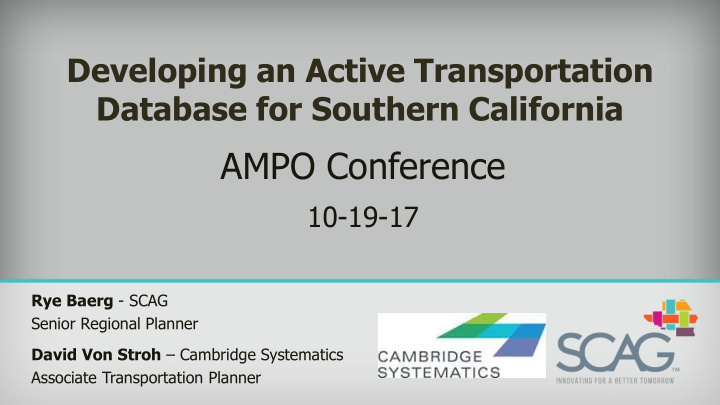



Developing an Active Transportation Database for Southern California AMPO Conference 10-19-17 Rye Baerg - SCAG Senior Regional Planner David Von Stroh – Cambridge Systematics Associate Transportation Planner 1
About SCAG Nation’s largest Metropolitan Planning Organization (MPO) Governed by a Regional Council of 84 local elected officials Nation’s Global Gateway for Trade 2
SCAG’s Active Transportation Program Open Streets & Sustainability Toolkits/ Advertising Temporary Planning Toolbox Campaign Events Grants 3
Background SCAG is Los Angeles area MPO Bicycle Data Clearinghouse Released in 2012 w/ UCLA Allows storage of manual counts Primarily focused on bicyclists 4
Original Deliverables Conducting Bicycle and Pedestrian Count Manual Count Forms Literature Review Modeling Integration White Paper Union Station Bike Count Report 5 5
Goals of the Update Integrate Pedestrian Data Improve User Interface Improve Data Retrieval and Reporting (incl. TMG) Support Mobile App Integration Provide a Planning Tool for ATP, TIGER grants, other Integrate Automated Counters Support Regional Modeling Efforts Counter siting plan, incl. stratification factors 6 6
Stakeholder Outreach Online survey to 100+ jurisdictions Interviews with county and transit agency modeling and bike/ped staff Needs: • Grant application support, integration of related data (census, safety, vehicle traffic) • Standardized procedures for counting • Easy upload/download of data 7
State of Practice Outreach Interviews with peer agencies and national thought leaders Recommendations/ideas: • Leverage one week counts with permanent counters – develop annualization factors • Conform to TMG October 2016 Update • API to feed data to public and third party developers • Data visualization and user interface options 8
New Database Schema Conforms to 2016 TMG Bike and ped data Automated & manual counts Interval volumes or individual timestamped observations Screenlines or turning movements User characteristics (helmet, gender, age, WC) Environmental characteristics 9
New Website User Interface Count management/ assignment Location management Data upload 10 10
Mobile Counter App Collect real time observational data Optional traveler characteristics (helmet, gender, age, WC) Integrated with count assignments from website 11 11
Additional Components ESRI data viewing and download portal Automated counter interface (API) Flexibility to receive and standardize counts from any source, many formats 12 12
Future Considerations New technologies: Video recognition, Bluetooth MAC tracking, Phone GPS traces Potential to integrate with social tracking app data Many screenlines can weight penetration of apps Environmental characteristics (facility width, pavement condition, etc.) correlation with count volumes 13 13
Recommend
More recommend